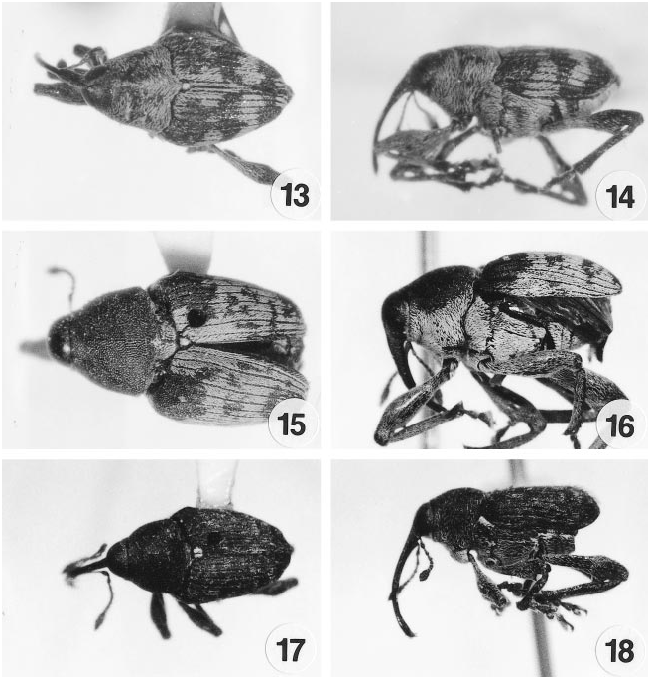Curculio lisae Pelsue and Zhang
|
publication ID |
https://doi.org/10.1649/0010-065x(2000)054[0467:arotcf]2.0.co;2 |
|
DOI |
https://doi.org/10.5281/zenodo.15700360 |
|
persistent identifier |
https://treatment.plazi.org/id/8C170A27-B610-9470-FE9D-A1EFFC47FEB1 |
|
treatment provided by |
Carolina |
|
scientific name |
Curculio lisae Pelsue and Zhang |
| status |
sp. nov. |
Curculio lisae Pelsue and Zhang View in CoL , New Species
Figs. 13–14 View Figs
HOLOTYPE. China. Xishuangbanna : male [China/ Yunnan / Xishuangbanna /650 M/ 03 August 1958 / X. Meng] ( IZAS)
PARATYPE. (1) China. female [China/ Hainan Province / Ta Hian / 19 June 1935 / J. L. Gressitt] ( CASC)
Recognition Characters. Small to mediumsized, oval, slightly robust; derm uniformly piceous; rostrum, 0.53 as long as body, broad to antennal insertion then narrowing abruptly to apex; frons narrow, 0.16 as wide as head across eyes; antennal club as long as scape, longer than funicular segments 4– 7; elytra with fascia of clavate, luteous scales basally, broad fascia before middle of clavate, luteous scales and a narrow vitta of clavate, luteous scales on intervals 1 and 2 toward apex.
Female: Length: 3.4–4.0 mm. (mean = 3.7) Width: 1.8–2.0 mm. (mean = 1.9) Head: Smallsized, feebly convex; punctures small, clothed with short, narrow, white to testaceous scales; eyes large, finely faceted, contiguous to anterior margin of pronotum; ventromedially below eyes with macula of short, narrow, luteous scales. Frons narrow, 0.15 as wide as head across eyes; vestiture of narrow, elongate, fuscous scales; interocular fovea lacking. Rostrum: Length: 2.0– 2.1 mm. (mean = 2.05); 0.56 as long as body; cylindrical; thick at base to antennal insertion, dorsally abruptly narrowing to slender tube to apex; median dorsal carina flanked by a sulcus on each side to antennal insertion; punctures small, with narrow, elongate, white, to piceous scales to antennal insertion, small round punctures beyond antennal insertion to apex; gradually arced to apex; scrobe ventral; scape inserted in basal third. Antennae: Length: Scape 0.5 mm; Funiculus: segment one 0.28 mm, two 0.18 mm, three 0.1 mm, four 0.1 mm, five 0.1 mm, six 0.1 mm, seven 0.1 mm, club 0.5 mm; funicle 1.3 mm; scape 0.39 as long as funicle and club; funicular segment two almost half as long as one; vestiture of narrow, elongate, decumbent to erect, dirty, white scales; club elongate, oval, compact, clothed with velvety pile, with few erect setae, first two segments fuscous, longer than funicular segments 4–7. Thorax: Length: 1.0– 1.2 mm. Width: 1.4–1.6 mm. 0.75 as long as broad; disc margin subparallel, angled from base to constriction, slightly rounded; disc flat in lateral view, lacking median dorsal carina; punctures small, uniformly clothed dorsally, laterally and ventrally with narrow, clavate, luteous scales; base sinuate, with shallow declivity; mesosternal intercoxal process prominent, clothed with luteous scales; scutellum small, as broad as long, subimpressed with luteous scales; mesepimeron, mesepisternum, and metasternum uniformly clothed with narrow, clavate, luteous scales. Elytra: Length: 2.1–2.3 mm. Striae narrow and shallow, with narrow, elongate, fuscous scales; humeri feebly prominent, rounded; disc flat in lateral view; intervals broad, flat; lateral base of pronotum with fasica of narrow, elongate, luteous scales; anterior to middle with broad fascia of narrow, elongate, luteous scales; toward apex, with narrower fascia on intervals 1–7 of narrow, elongate, luteous scales; all other scales fuscous except for scattered, luteous scales; crosshatched setae short, stout and piceous. Legs: Length of hind femur 1.6–1.9 mm, all femora with smallsized tooth; hind femoral tooth wedge shaped; hind femur lacking proximolateral sulcus; vestiture of all femora with narrow, elongate, luteous scales, with acute apices; tibial margins subparallel, feebly sinuate; pro and mesouncus large, as long as tarsal claw, metauncus small, not as long as tarsal claw; scales on tarsal segments uniformly fuscous, pad of segment three luteous. Abdomen: Sternite 1 as long as 2, behind coxal cavity; sternite 2 longer than 3, ascending to 3; sternites 3 and 4 combined, not longer than 5; sternite 5 with acute apex; vestiture of all abdominal sternites of narrow, elongate, to clavate, luteous scales. Pygidium: Small , visible.
Distribution. China: Yunnan Province, Xishuangbanna, 650 M, 03 August 1958, X. Meng; Hainan Island, Ta Hian, 19 June 1935, J. L. Gressitt, (CASC).
Remarks. Genitalia for this species was not obtained. This species is unique within this group and named in honor of the senior author’s daughter Lisa.
| IZAS |
Institut Zoologii Akademii Nauk Ukraini - Institute of Zoology of the Academy of Sciences of Ukraine |
No known copyright restrictions apply. See Agosti, D., Egloff, W., 2009. Taxonomic information exchange and copyright: the Plazi approach. BMC Research Notes 2009, 2:53 for further explanation.
|
Kingdom |
|
|
Phylum |
|
|
Class |
|
|
Order |
|
|
Family |
|
|
Genus |

